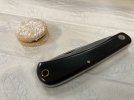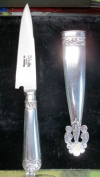CelloDan
Basic Member
- Joined
- Dec 2, 2017
- Messages
- 3,357
Yes, it's a verijero, just a tiny bit smaller than my first one.Thank you for sharing the backstory on your new cuchillo criollo. Is it another verijero?
I love both my children


Yes, I am still pinching myself.Right around the corner and picked up in person? That knife was meant to be yours.
I was SO excited Sunday and could not unwind. I had a lot trouble sleeping that night. I paid the price the next day ( yesterday ) lol
The entire package is beautiful. I'm very happy for you.
Now we just need to work on getting you a Boker or Herder.
Gracias amigo
You read my mind about Boker or Herder next

Actually I saw criollo blade blanks for sale at Boker Arbolito in Argentina. They are made with thick stock of 4.8 mm and in carbon steel like the original Arbolitos, the grail blade of so many gauchos.
They state they have remade the dies recently with the exact dimensions as the old ones that wore out after a century of use. It looks like they only ship in Argentina though.
Here is the blade blank. I am thinking about attempting to put a handle on it myself

A Boker Arbolito added to my criollo stable will give me the perfect trifecta

1) A beautiful criollo hand made and forged by a very talented Argentine contemporary maker
2) A well preserved example of Argentine cutlery with exquisite "plateria" work and a Tandil made blade
3) A German made Boker Arbolito blade, the grail of so many gauchos combined with my own work in putting a handle on it. ( hopefully I can put a checkmark as well on option # 3 this spring ) I will go for at least a 6 inch blade to complement my two smaller verijeros.

























